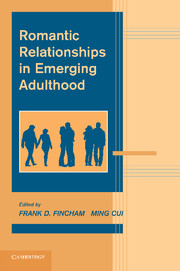Book contents
- Frontmatter
- Contents
- List of Contributors
- Foreword
- PART I INTRODUCTION
- PART II CONCEPTUAL AND METHODOLOGICAL FOUNDATIONS
- PART III THE DEVELOPMENTAL CONTEXT OF ROMANTIC RELATIONSHIPS IN EMERGING ADULTHOOD
- PART IV RELATIONSHIP PROCESSES IN EMERGING ADULTHOOD
- PART V PRACTICAL IMPLICATIONS
- 14 Romantic Relationships and Mental Health in Emerging Adulthood
- 15 Relationship Education in Emerging Adulthood: Problems and Prospects
- 16 Romantic Relationships and Academic/Career Trajectories in Emerging Adulthood
- Index
- References
15 - Relationship Education in Emerging Adulthood: Problems and Prospects
Published online by Cambridge University Press: 06 December 2010
- Frontmatter
- Contents
- List of Contributors
- Foreword
- PART I INTRODUCTION
- PART II CONCEPTUAL AND METHODOLOGICAL FOUNDATIONS
- PART III THE DEVELOPMENTAL CONTEXT OF ROMANTIC RELATIONSHIPS IN EMERGING ADULTHOOD
- PART IV RELATIONSHIP PROCESSES IN EMERGING ADULTHOOD
- PART V PRACTICAL IMPLICATIONS
- 14 Romantic Relationships and Mental Health in Emerging Adulthood
- 15 Relationship Education in Emerging Adulthood: Problems and Prospects
- 16 Romantic Relationships and Academic/Career Trajectories in Emerging Adulthood
- Index
- References
Summary
The literature on emerging adulthood (EA) has focused heavily on basic research, a reflection no doubt of continuing debate about fundamental features of this stage of development (see the special issue of Child Development Perspectives, 2007). Therefore it is not surprising that examination of applied issues relating to romantic relationships in EA has been limited to documenting an association between romantic relationships and psychological adjustment (see Chapter 14) and to showing that the quality of such relationships mediates the link between earlier parent–adolescent relationships and later mental health outcomes (Beyers & Seiffge-Krenke, 2007). The purpose of this chapter is to broaden attention to applied issues in the EA literature by considering how to facilitate what seems to be a prerequisite to entering adulthood: the ability to initiate and sustain an intimate romantic relationship with another person.
WHAT IS RELATIONSHIP EDUCATION AND IS IT NECESSARY?
Historically, relationship education has taken the form of marriage education and has been offered almost exclusively to couples. Such marriage education has its roots in religious institutions, and the precursor to modern programs was Pre-Cana premarital counseling now required of couples wishing to marry within the Catholic Church (Ooms, 2005). Until quite recently, most relationship education occurred in religious contexts, thereby excluding those who do not profess a religious faith or who are uncomfortable in such settings. Nonetheless, a substantial minority of marrying couples (44%) in the 1990s received some type of relationship education before marriage (Stanley, Amato, Johnson, & Markman, 2006).
- Type
- Chapter
- Information
- Romantic Relationships in Emerging Adulthood , pp. 293 - 316Publisher: Cambridge University PressPrint publication year: 2010
References
- 14
- Cited by



